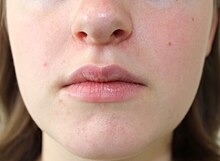Perioral dermatitis
| Classification according to ICD-10 | |
|---|---|
| L71.0 | Perioral dermatitis |
| ICD-10 online (WHO version 2019) | |
The perioral dermatitis (also: mouth Rose , Stewardessen- or mannequin's disease or rosacea -like dermatitis ) is a harmless skin disease with a characteristic bläschenhaftem rash ( " papules ") in the face, especially around the mouth and eyes.
Clinical picture
Usually around the mouth ( perioral ) or sometimes on the eyelids or their surroundings, you can usually see numerous, densely packed, tiny, inflamed red nodules or vesicles. A small border around the lips remains free. Sometimes these tiny nodules can flow together into larger areas and form plaques . The nasolabial folds , i.e. the areas from the nostrils down to the corners of the mouth, as well as the lateral areas of the chin, are most frequently affected. This creates the impression of a ring-like distribution.
root cause
The exact cause of the disease is unknown. If skin is over-cared for, it is no longer able to produce the necessary fats itself , so that it becomes dry and flaky. Out of ignorance, the affected areas of the skin are then cared for and creamed even more intensively, which intensifies and widens the rash. Often there is a genetic disposition , and perioral dermatitis does not break out until a trigger comes into play. The most well-known triggers are stress , fungal attack , bacteria , toothpaste containing fluoride and the long-term use of cortisone preparations . The symptoms appear almost exclusively in women of younger to middle age. At the same time, there is often vegetative instability (headache, sleep disorders, constipation) and there is also a connection with long-term partnership or professional stress. Perioral dermatitis can occur even after stopping birth control pills . The often significantly impaired appearance means that cosmetics and skin care products, including ointments containing cortisol (often called hydrocortisone ), are increasingly being used for supposed care or therapy . These ointments initially lead to an improvement, but this is only of short duration. Then the rash experiences a new flare-up and intensifies despite further treatment with cortisol ointment. Perioral dermatitis is also often referred to as stewardess disease because a stewardess is the prototype of a patient: 25–40 years old, well-groomed appearance.
therapy
The causes mentioned must be eliminated for therapy. In particular, the regular use of cosmetic creams ("moisturizers") should be avoided. The affected areas of the skin may only be cleaned with water. The symptoms can initially be more pronounced: the skin is tight and burning. The inflammatory reddening is more pronounced. The inflammation can even become oozing in character. Then the patients have to exercise self-discipline in order not to resort to their usual skin care routine and thus get into a vicious circle . If in doubt, the doctor should be consulted. If you manage to go without your cosmetics for about six weeks to three months, the symptoms will go away. However, the first visible successes can sometimes be seen after just three weeks. Envelopes dipped in black tea are also recommended. The so-called tanning agents are effective here . In order for the tea to release enough tannin, it has to steep longer (approx. 10 minutes) and then cool down sufficiently, as warmth would promote inflammation.
Occasionally, medication prescribed by a doctor (such as erythromycin gel, azelaic acid gel or a cream containing metronidazole ) can bring about faster improvement. In the case of pronounced inflammatory forms, taking antibiotics ( tetracyclines , minocyclines ) is the means of choice. These preparations usually have to be taken for a few weeks. Corticosteroids must be avoided because they can worsen after discontinuation or through habituation.
Further treatment must be discussed with the doctor.
Differential diagnosis
The symptoms can be mistaken for eczema , acne, or rosacea . A seborrheic dermatitis occurs as the perioral dermatitis in a similar distribution. However, the eczema has a rather flat character in contrast to the mostly "pimple-like", ie rather point-like changes in perioral dermatitis. The scaling is often more pronounced. In addition, with seborrheic dermatitis, eczematous skin changes can also be found in other regions of the face or scalp (hairy areas, ears, beard area). Acne is characterized by a different distribution pattern on the face (more likely cheeks, temples and forehead) and the presence of blackheads ( comedones ). Rosacea can be similar to perioral dermatitis, but is mostly localized not around the mouth, but rather on the cheeks or forehead. The inflammatory papules are usually somewhat coarser.
Web links
- Typical picture of perioral dermatitis ( Memento from September 5, 2013 in the Internet Archive )
swell
- ↑ a b c d e ratgeber-hautgesundheit.de: Perioral dermatitis is also called stewardess disease
- ↑ Nicole Schuster: Over-cared for skin. In: Pharmaceutical newspaper . April 15, 2015, accessed August 12, 2020 .
- ↑ a b c lifeline.de: Oral rose - how cosmetics irritate the skin
- ↑ a b drbresser.de: perioral dermatitis, stewardess disease

